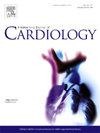How accurate is intraprocedural transthoracic echocardiography in assessing aortic regurgitation after transcathether aortic valve implantation? A single center experience
IF 3.2
2区 医学
Q2 CARDIAC & CARDIOVASCULAR SYSTEMS
引用次数: 0
Abstract
Aim Transthoracic echocardiography (TTE) has been commonly used to assess the aortic regurgitation (AR), particularly paravalvular leakage, during transcatheter aortic valve implantation (TAVI). We sought to investigate the accuracy of intraprocedural TTE to grade the AR severity by comparing with discharge TTE assessments.
Methods Consecutive patients received balloon expandable (BE) or self-expanding (SE) transcatheter heart valves with both intraprocedural TTE and discharge TTE AR assessments were included. The AR was assessed following the standard approach intraprocedurally by one dedicated interventional echocardiographer and at discharge by one echo-cardiologist.
Results In total 404 patients, the AR grade was concordant in about 2/3 of the population and discordance was mainly underestimation of AR severity with intraprocedural TTE. None or trace intraprocedural AR was more seen in patients with BE valves and the concordance with discharge assessment was also higher in BE valve group than that of the SE valve group. The discordance was mainly underestimation too, regardless of valve types.
Conclusion in our single-center real-world experience, the AR assessed with intraprocedural TTE was discordant with the discharge TTE in about 1/3 of the cases with predominantly underestimation.
术中经胸超声心动图评估经导管主动脉瓣植入术后主动脉反流的准确性如何?单中心体验
目的经胸超声心动图(TTE)通常用于评估经导管主动脉瓣植入术(TAVI)中主动脉瓣反流(AR),特别是瓣旁渗漏。我们试图通过比较术中TTE与出院TTE评估来调查术中TTE分级AR严重程度的准确性。方法对连续接受球囊膨胀性(BE)或自膨胀性(SE)经导管心脏瓣膜的患者进行术中TTE和出院TTE AR评估。术中由一名专门的介入超声心动图医师和出院时由一名超声心动图医师按照标准方法评估AR。结果404例患者中,约2/3患者的AR分级一致,不一致主要是术中TTE对AR严重程度的低估。BE瓣膜组患者术中无AR或明显AR发生率高于SE瓣膜组,且BE瓣膜组与出院评估的一致性高于SE瓣膜组。无论瓣膜类型如何,这种不一致也主要是低估。结论在我们的单中心真实世界经验中,术中TTE评估的AR与出院TTE不一致的病例约占1/3,主要是低估。
本文章由计算机程序翻译,如有差异,请以英文原文为准。
求助全文
约1分钟内获得全文
求助全文
来源期刊

International journal of cardiology
医学-心血管系统
CiteScore
6.80
自引率
5.70%
发文量
758
审稿时长
44 days
期刊介绍:
The International Journal of Cardiology is devoted to cardiology in the broadest sense. Both basic research and clinical papers can be submitted. The journal serves the interest of both practicing clinicians and researchers.
In addition to original papers, we are launching a range of new manuscript types, including Consensus and Position Papers, Systematic Reviews, Meta-analyses, and Short communications. Case reports are no longer acceptable. Controversial techniques, issues on health policy and social medicine are discussed and serve as useful tools for encouraging debate.
 求助内容:
求助内容: 应助结果提醒方式:
应助结果提醒方式:


